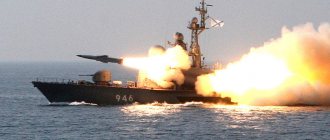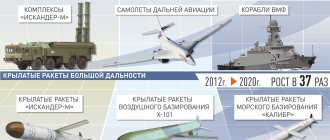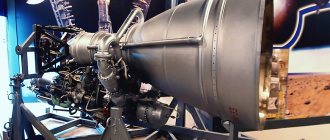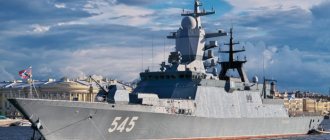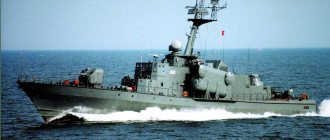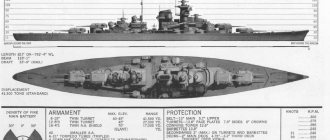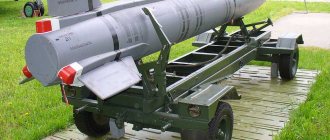Various weapons can be used to combat enemy ships, but the leading role currently belongs to anti-ship cruise missiles. In the past, however, other options for anti-ship weapons were also considered. In particular, the issue of creating ballistic anti-ship missiles was studied. Several similar projects have been developed in our country, none of which, however, have reached practical application.
The idea of a ballistic missile designed to destroy large surface ships took shape towards the end of the fifties . By that time, our country’s potential opponents had managed to build numerous and powerful fleets, which had to be fought at distant approaches. Cruise missiles already existed for long-range bombers and submarines, but their flight range did not meet current requirements. Both the carrier aircraft and the submarine would be forced to enter the defense zone of the enemy naval group.
Submarine ballistic missiles were seen as an obvious way out of this situation. Having small dimensions and weight, a product of this class could fly at a distance of up to several thousand kilometers. Thanks to this, it became possible to attack a naval formation from a safe area. By the early sixties, the formation of a new concept was completed, which made it possible to move from research to development work.
Projects D-5T and D-5Zh
The first participant in the new program for the development of ballistic anti-ship missiles for submarines was the Leningrad TsKB-7 (now the Arsenal Design Bureau named after M.V. Frunze) headed by P.A. Tyurin. Since 1958, this organization has been developing the D-6 complex with a fundamentally new solid-fuel rocket. A study of the issue showed that such a missile can be taken as the basis for a promising anti-ship missile with fairly high performance. As a result of this, a project was launched with the working designation D-5T.
Model of the D-6 missile at the parade.
The basic rocket of the D-6 complex was a two-stage product with solid propellant engines. At each stage it was proposed to use four independent engines in separate housings. In addition, starting engines were provided on the head fairing, designed to exit the launcher. The development of the new project showed that the D-5T missile will be able to fly at a range of up to 1500-2000 km. The increase in range in comparison with the base model was achieved by reducing the mass of the warhead.
At the beginning of 1961, Miass SKB-385 (now the State Research Center named after V.P. Makeev) joined the work on a new topic. His project, which received the working designation D-5Zh, envisaged the creation of a completely new rocket with a liquid power plant. Such a missile could send a special warhead to a range of up to 1,800 km.
The D-6 complex was to be carried by diesel-electric and nuclear submarines of several projects. Only a specialized modification of Project 661 was considered as a carrier for the D-5T system. The issue of creating such a submarine was studied at TsKB-16 (now SPMBM Malachite). Later, after the appearance of the D-5Zh project, a proposal appeared to adapt two complexes for use on modified Project 667 submarines. However, the development of such a project took time, which led to the emergence of an unusual proposal. SKB-385 was tasked with developing a version of a ballistic anti-ship missile for deployment on special surface ships.
Further development of the two projects led to the abandonment of the solid-fuel rocket. It was found that the D-5Zh complex would be more convenient to use, and therefore this particular project should be developed. Further development of the new project was carried out under the designation D-5. Finally, another important decision was made. A promising submarine weapon was to be a new modification of the missile, which was initially developed as part of the ship’s weapons project.
There are “Daggers”, but there are no “Zircons”. What is the Russian army armed with?
According to Sergei Shoigu, according to the results of the Unified Acceptance Day, in 2021 the Russian army received more than 5,000 units of weapons and equipment. These statistics include not only tanks, aircraft, ships and submarines, but also auxiliary and engineering equipment. Thus, significantly fewer heavy strike weapons were supplied.
“If Russia invades Ukraine, the Americans will have to pay for it”
Western media and politicians have been regularly talking in recent days about an impending “Russian invasion”...
21 January 16:12
Of the above, these are 900 armored combat vehicles, of which 240 are T-72B3M, T-80BVM and T-90M “Proryv” tanks. Among them are both those that have undergone deep modernization and completely new tanks that will roll off the assembly line in 2022.
Last year, the troops received three Bastion coastal missile systems, Pantsir-S anti-aircraft missile and gun systems, and S-400 Triumph and S-350 Vityaz anti-aircraft missile systems. The rearmament of the first regiment with the Avangard missile system has been completed (the regiment has taken up combat duty in the Yasnenskaya missile division, which is stationed in the Orenburg region). The regiment of the Barnaul division of the Strategic Missile Forces is being re-equipped with Yars strategic missile systems - the missilemen will begin full combat duty in April 2022.
The Russian Navy has trained three modern submarines, including the nuclear submarine cruiser Prince Oleg, armed with Bulava ballistic missiles, four surface ships, 10 combat boats, 17 ships and support boats.
The Aerospace Forces, in turn, received 151 units of new and modernized aviation equipment - 77 aircraft, 29 helicopters, 45 complexes with unmanned aerial vehicles. This list also includes four modernized Tu-95 MS missile carriers. A separate aviation regiment has been formed, armed with MiG-31IK high-altitude fighter-interceptors with the Kinzhal hypersonic missile.
However, this list did not include the Zircon hypersonic missiles, the T-14 Armata tanks, the Prometheus air defense missile system-500, or the Su-57 fifth-generation fighters.
“We need to quickly sell Kyiv as many junk weapons as possible”
The US State Department has authorized Latvia, Lithuania and Estonia to transfer American weapons to Ukraine, about...
January 20 20:57
“There is no need to rush things, all this military equipment will appear in the Russian army this year,” Doctor of Military Sciences Konstantin Sivkov told Gazeta.Ru. – Let’s look at specific positions of the latest weapons that have already completed testing. A salvo launch of Zircon hypersonic anti-ship missiles was carried out at the end of last year in the Barents Sea, and already in January of this year the State Commission recommended that this cruise missile be adopted into service with Navy surface ships. The S-500 Prometheus anti-aircraft missile systems also began to be mass-produced last year and are already entering service with the troops. Rostec announced the start of mass production of T-14 tanks on the Armata platform at the end of last year - there are 25 of them so far, but the process has begun. The situation is similar with the fifth-generation Su-57 fighters - the Ministry of Defense has entered into a state contract for the supply of such aircraft, which are planned to be equipped with three aviation regiments of the Aerospace Forces.”
According to Shoigu, the equipment of the army and navy with modern weapons has increased to 71.2%, and of the strategic nuclear forces - to 89.1%, the serviceability of military equipment is maintained at 95%.
Thus, everything is going according to the plan approved in 2022 by President Vladimir Putin, who ordered to increase the overall equipment of the army with modern weapons “by at least 70% by the end of 2022, and by 2027 to reach 75%.”
“We are not behind anyone, we are just adjusting our weapons development and we can do it as we please. We do not focus on those weapons that we still talk little about; we do not advertise them and, by and large, do not declassify them. These include attack reconnaissance drones and modern radio-electronic equipment, including reconnaissance and electronic warfare. But all this will also soon go to the troops,” reserve major general, president of the College of Military Experts of Russia Alexander Vladimirov told Gazeta.Ru.
Complex D-5 with R-27K missile
In April 1962, the USSR Council of Ministers decided to begin the development of a new anti-ship missile system for submarines. The complex as a whole was designated as D-5, the missile for it was designated R-27K or 4K18. As follows from the designation, the new anti-ship missile was supposed to be a special modification of the existing medium-range missile of the R-27 type.
Over the course of several months, SKB-385 formed the appearance of the new complex and determined the range of necessary modifications to the existing rocket. It was proposed to use a two-stage rocket, in which the first stage was responsible for launching the second onto a given trajectory. The second stage, accordingly, was supposed to carry homing equipment and a warhead. Since we were talking about hitting moving targets, the missile had to carry detection and homing means.
The R-27K missile (left) and the base R-27 during testing.
At the same time, it was found that the development of anti-ship missiles faces a number of difficulties. Thus, guidance and control equipment with the required characteristics turned out to be too large. Because of this, the second stage could occupy up to 40% of the permissible dimensions of the product. In addition, the homing head had to be covered with a radio-transparent heat-resistant fairing. There were no suitable materials in our country at that time.
The existing difficulties led to the emergence of two preliminary projects at once. They used a common first stage, based on the components of the R-27 rocket, and the second stages were developed from scratch. The first stage differed from the basic design by a shortened body with tanks of reduced capacity. 4D10 engine, controls, etc. remained the same. Two versions of the second stage, differing in equipment and operating principles, received the designations “A” and “B”.
Both projects proposed the use of a passive radar homing head with a side-view antenna. Until a given moment, the antenna, when folded, had to be inside the housing, and then go out and unfold. At the same time, it was possible to search for signals from the radio-electronic systems of the enemy ship, by which it was possible to determine its location and adjust the course of the missile.
Project "A" proposed a relatively complex control system. On the ascending part of the trajectory, the rocket had to correct the trajectory using special second-stage engines. When moving down towards the target, it was necessary to use aerodynamic rudders and adjust the course according to data from the head antenna, which received signals from the front hemisphere. In Project “B” it was proposed to use course correction only before reaching the downward section of the trajectory. The first version of the guidance equipment was much more complex, and also increased the dimensions of the second stage, but at the same time could provide higher accuracy in hitting the target.
The second stage version with the letter “B” was adopted for further development. Thus, the 4K18 / R-27K missile was supposed to search for a target using a passive seeker with a side-view antenna. There is no need for a head antenna. For further development of electronics, NII-592 (now NPO Avtomatiki) was involved in the project. With its help, an improved seeker with a more efficient antenna was created.
The R-27K product, according to the project, had a length of 9 m with a diameter of 1.5 m. The starting weight was 13.25 tons. Outwardly, it differed from the base R-27 by an elongated head fairing of a more complex shape. The second stage carried a special warhead with a power of 650 kt, capable of compensating for some reduction in accuracy. The rejection of a full-fledged power plant in the second stage and a decrease in the fuel supply in the first led to a reduction in flight range. Thus, the basic R-27 missile flew 2500 km, while the new 4K18 flew only 900 km.
It should be noted that work on the R-27 and R-27K projects was associated with certain difficulties. As a result, the basic ballistic missile entered service only in 1968, and anti-ship missile tests could begin only two years later. The first test launch of the 4K18/R-27K was carried out at the Kapustin Yar training ground in December 1970.
Diagram of the second stage of a 4K18 type “B” rocket.
Using a ground-based launcher, 20 test launches were carried out, of which only 4 were emergency launches. Next, several throw-out launches took place from a submersible stand. After this, work began to prepare the missile system for testing on a carrier submarine.
It should be noted that since the mid-sixties, the D-5 project has encountered certain difficulties in finding a carrier. Some submarines did not meet technical requirements, while others could not be used with anti-ship missiles because they had to carry strategic missiles. As a result, they decided to make the K-102 diesel-electric boat of Project 629 into an experienced carrier of the complex. In accordance with the new Project 605, it was supposed to receive four launch silos and a set of various equipment for working with missiles.
On December 9, 1972, the K-102 submarine launched the R-27K missile for the first time. The tests lasted about a year, and during this time 11 experimental missiles were used. On November 3, 1973, a pair of missiles were launched at a target barge. One 4K18 product hit the target exactly, while the second made a slight miss. It is important that at the time of the missile launch the uncertainty of the target position reached 75 km. Despite this, the missiles independently found the target and aimed at it.
Despite the successful completion of the tests, the D-5 / R-27K project was closed at the beginning of September 1975. A passive radar seeker could not provide the required reliability for solving problems, and countering it was not particularly difficult. The nuclear warhead, in turn, made it difficult to deploy submarines with new anti-ship missiles due to the presence of new international agreements. Finally, serious progress has already been made in the field of cruise missiles. In such a situation, the existing D-5 complex was of no interest to the fleet.
Sea-launched anti-ship cruise missiles
Anti-ship cruise missiles (ASCMs) are designed to strike enemy ships. They can be armed with both submarines and surface ships of various classes and displacements - from missile cruisers to “mosquito fleet” ships. Anti-ship missiles are the main strike weapon of modern ships in the fight against surface targets (not counting, of course, carrier-based aircraft, but only the US Navy currently has truly serious aircraft carrier forces).
Anti-ship missiles are developed and used as a complex: carrier ship, launcher, control complex and the missile itself.
CLASSIFICATION OF ANTI-SHIP CRUISES MISSILES
Experts usually divide anti-ship missiles into long-range (more than 200 km), medium-range (40...200 km) and short-range (5...40 km) missiles.
There are anti-ship missiles with semi-armor-piercing, high-explosive, high-explosive fragmentation, fragmentation and nuclear warheads.
HISTORY AND MAIN SAMPLES OF ANTI-SHIP CRUISE MISSILES
Anti-ship missiles originated as a class of weapons at the end of World War II: the German Henschel Hs293, the Japanese Okka - although these were air-launched missiles that were dropped from bombers. Sea-based anti-ship missiles began to develop in the 1950s, primarily thanks to the efforts of Soviet specialists. The Americans were then too fascinated by the capabilities of nuclear weapons, considering them “absolute” on land, at sea and in the air. The Soviet leadership considered it necessary to have specialized anti-ship weapons in service with the fleet. Anti-ship missiles in service with the USSR Navy were designed to compensate for NATO's enormous superiority in the number of surface ships.
In the second half of the 1950s. In the USSR, the P-15 Termit anti-ship missile is being created for container storage, which could be installed on any surface ship or boat. In connection with the adoption of ship-based anti-aircraft missile systems by NATO countries, Soviet anti-ship missiles could no longer overcome the air defense of a potential enemy, and the Soviet leadership decided to develop anti-ship missiles with supersonic flight speed. Supersonic anti-ship missiles K10S and P-35 are being created.
Anti-ship missile P-1000 "Vulcan" |
Only in the 60s. The leadership of NATO countries duly assessed the effectiveness of anti-ship missiles. In the late 60s - early 70s. in the West, anti-ship missiles "Harpoon" (USA), "Exocet" (France), "Otomat" (Italy) were created, and in 1981 the long-range cruise missile "Tomahawk" (USA) was put into service. By this time, the concept of a supersonic cruise missile traveling to a target at a high altitude had already outlived its usefulness - despite its high speed, it was detected by enemy air defense systems at a great distance and was quite easily intercepted. Therefore, emphasis began to be placed on the stealth of the missile: it had to fly at a height of only a few meters above the water, and thus remain “invisible” for as long as possible. However, for supersonic cruise missiles this concept turned out to be unacceptable: too much air resistance at low altitude caused excessive fuel consumption and reduced the missile’s range of action. Therefore, in Soviet anti-ship missiles, the developments of the 70s - 80s. – P-700 “Granit” and P-800 “Oniks” a combined flight pattern was implemented: for most of the trajectory the rocket flew in rarefied layers of the atmosphere at an altitude of 15-20 thousand m, and on the final section of the trajectory it dropped to an altitude of 20-50 m The Soviet subsonic anti-ship missile Kh-35 was also developed with a speed of 0.9 M and a flight altitude of 10-15 m on the cruising section, and 4 m on the final section.
In general, the Soviet fleet, which never had powerful carrier-based aircraft, in the fight against the navy of a potential enemy could only rely on its anti-ship missiles, which were more advanced than their Western counterparts. To destroy large enemy surface ships, and primarily aircraft carriers, it was planned to use a salvo of several dozen P-500 Basalt and P-700 Granit anti-ship missiles. These supersonic long-range missiles with a very powerful warhead constituted the main armament of the Kirov-class heavy nuclear-powered missile cruisers, the Slava-class missile cruisers, the heavy aircraft-carrying cruiser Admiral Kuznetsov and the Project 949A nuclear-powered missile-carrying submarine cruisers Antey.
The most advanced example of Russian missile systems of this type today is the P-1000 Vulcan. This anti-ship missile system implements an “artificial intelligence” system: missiles in a salvo exchange information, are automatically distributed among targets in the enemy order of ships depending on their importance, and carry out anti-aircraft maneuvering. The supersonic speed of the anti-ship missile (up to 2.5M) and the armored warhead make it easier for the missile to break through the enemy's air defense system. The firing range of the P-1000 has been increased to 700 km. Currently, ships that were previously armed with P-500 and P-700 anti-ship missiles have been re-equipped with P-1000 missiles.
To destroy ships with a displacement of up to 20,000 tons, the USSR/Russia created the P-270 Moskit missile. This supersonic (speed up to 2.8 M) missile, equipped with a warhead weighing 300 kg, can be used at a range of up to 120 km when flying over water and up to 250 km when flying at high altitude. When flying over water, the missile passes the main part of the trajectory at an altitude of 20 m, and at the target it drops to 7 m and can perform an anti-aircraft maneuver.
GENERAL DEVICE OF RCC
As a rule, a missile complex includes the following main systems: storage, control, pre-launch preparation and launch. The missile, in turn, consists of a body, a warhead (warhead), an engine with fuel and an on-board control system.
As is known, a cruise missile (we will consider only them below) flies due to the lifting force arising on its load-bearing surfaces. Anti-ship missiles usually have a cruciform wing and the same tail with control rudders. The aerodynamic layout is often made according to the usual (aircraft) design with rudders in the tail section (anti-ship missiles “Tomahawk”, “Harpoon”, “Exocet”, etc.).
| Anti-ship missile "Tomahawk" |
The rocket body is usually made of aluminum alloys. The total mass of the missiles under consideration varies within fairly wide limits: 300 kg (Sea Killer), 850 kg (Exoset MM-40) and 1225 kg (Tomahawk).
Anti-ship missiles use semi-armor-piercing (Harpoon, Exocet) or high-explosive (Otomat) warheads, which are considered the most effective for destroying ships. The explosive mass of the warhead ranges from 60 (Sea Killer) to 180 kg (Harpoon) and 500 kg (Tomahawk and P-1000 Vulcan).
There are also nuclear warheads for anti-ship missiles. The BGM-109A Tomahawk missile is equipped with a 200 kt nuclear warhead. The P-700 "Granit" and P-1000 "Vulcan" missiles can be equipped with a nuclear warhead, according to some sources, with a yield of up to 500 kilotons.
Most missiles with conventional warheads have a delayed-action contact fuse designed to allow the missile warhead to penetrate the ship. Often an additional proximity fuse is also installed, which is triggered when the missile flies over the target (in case of a miss). Usually the warhead also has a self-destructor, which detonates the missile if it misses.
Turbojet (TRJ), turbofan (TRF) and solid propellant (SDTT) engines are used as propulsion engines for anti-ship missiles. Turbofan engines and turbofan engines, as is known, use atmospheric air as a fuel oxidizer (kerosene) and are used on long- and medium-range missiles (Tomahawk, Harpoon, Otomat, etc.). Almost all short-range missiles (Gabriel, Penguin, etc.) are equipped with solid propellant rocket engines.
| RCC "Exoset" |
If a sustainer turbojet engine is used on a rocket, it is equipped with a powder starting engine (accelerator), which ensures its flight in the first seconds (2...6 s) until it reaches a speed at which normal operation of the sustainer turbojet engine is possible. Solid propellant rocket engines used on short-range missiles usually have two stages: one, more powerful, for short-term operation at the moment of launch (2...3 s), the second sustainer - to ensure a relatively long flight of the missile to the target (80...100 s). Anti-ship missile engines produced by NATO countries provide only subsonic flight speeds of 0.7...0.95M. In general, when developing anti-ship missiles in the West, the emphasis was on high accuracy and stealth. At the same time, Soviet (Russian) anti-ship missiles “Granit” and “Vulcan” develop a much higher speed than foreign missiles - 2-2.5M. This, as well as the armoring of the warhead, increases their ability to break through enemy air defenses.
The onboard missile control system is designed to maintain a given trajectory and flight mode, as well as to select a target and point the missile at it during the final phase of the flight without the participation of the ship's guidance equipment. The anti-ship missiles under consideration often use purely autonomous control systems (Harpoon, Otomat, etc.), which free the ship's crew from the need to point the missile at the target. Their inertial system is based on the property of a top to maintain the plane of its rotation; active radar homing head (GOS) is a small radar; The infrared (thermal) seeker is used to target the ship's thermal field. As for the semi-active radar seeker, it involves the participation of the ship’s equipment, which, as it were, illuminates the target, irradiating it with its radar so that the reflected rays are used by the missile seeker. With a radio command control system (Sea Killer, Gabriel Mk-1), the missile is aimed at the target from the ship using coded radio commands. In this case, radar or optical tracking of the target and the missile is carried out from the ship. The Tomahawk BGM-109A missile uses an original guidance system, briefly discussed below.
| Performance characteristics of some anti-ship cruise missiles | ||||
| "Tomahawk" BGM-109B | Exocet MM .40 block 3 | "Otomat" Mk.2 | "Vulcan" P-1000 | |
| Year of adoption | 1981 | 2007 | 1974 | 1987 |
| A country | USA | France | Italy | USSR/Russia |
| Range, km | 550 | 180 | 100 | 700 |
| Warhead type | Semi-armor-piercing | Semi-armor-piercing | High explosive | High explosive-cumulative |
| Warhead mass, kg | 500 | 160 | 200 | 500 (explosive mass) |
| Speed, M | 0,95 | 0,93 | 0.9 | 2-2,5 |
| Guidance system | Inertial and active radar seeker | Inertial and active radar seeker | Inertial and active radar seeker | Inertial and active radar seeker |
As is easy to see, all non-autonomous missile guidance systems, i.e. semi-active radar, beam and command, provide for the participation of the ship's crew in controlling the missile to the target. This certainly hinders the ship's maneuvers.
The complexes under consideration provide for the flight of missiles at a height of 10...15 m above the water surface, which greatly complicates their detection by the radar of the target ship. The homing system (SN) of the missile “captures” the target at a distance of 10...15 km and takes control of the flight. At a distance of 10...15 km from the target, the missile sometimes drops to an extremely low altitude of 2...5 m (Harpoon, Exoset, etc.), at which it flies to the target. The flight program for the Harpoon and Otomat Mk-2 missiles at a distance of 2...7 km to the target provides for the missile to rise (slide) to 150...200 m with a subsequent dive to the target. It is believed that such a slide increases the effectiveness of an attack on a maneuvering target and reduces the likelihood of a missile flying over the target ship, especially in rough conditions.
As a rule, anti-ship missile launchers on ships are also used for storage. In this case, they are round or rectangular containers, often paired. Storing missiles in containers with the required microclimate is very important to ensure the reliability of missiles, especially in stormy or winter conditions, as well as to increase their readiness for immediate launch. At the same time, the shelf life of missiles in containers is limited to a certain period of time: between periods of preventive maintenance is about a year, and the total shelf life is 10-15 years.
Launchers are sometimes made rotating and with a variable elevation angle, but there are also those fixedly mounted on the deck. Typically, a missile's flight program provides for the possibility of launching it at a significant angle from the direction towards the target, up to 180° (Otomat, etc.), i.e. in the opposite direction. However, there are complexes where these angles are insignificant and in this case the launcher is provided with a rotary one in order to lessen the maneuvering of the ship before launching missiles.
The main equipment of the missile monitoring, verification and launch systems, as well as the control systems, is usually located in the corresponding combat missile defense station.
PROSPECTS FOR THE DEVELOPMENT OF ANTI-SHIP MISSILES
Currently, the development of anti-ship missiles continues, primarily in the direction of further increasing their range and reducing radar signature. At the same time, the developers are trying to follow the path of maximum unification of the rocket technology being created, so that, based on one sample, modifications can be created to solve a variety of problems. An example of this approach was the promising Russian Club missile system, on the basis of which the Club-N or “Caliber” short-range ship-based missile system was created. This rocket implements another interesting technical solution: the entire path of the rocket travels at low altitude and subsonic speed, and when approaching the target it accelerates sharply.
The United States is currently developing a number of promising sea-based anti-ship missile systems. There is a tendency here to adapt the weapons of the American Navy to the tasks that they most often now face. And this is by no means the destruction of the fleets of technologically advanced powers. Recently, the United States has been fighting with much weaker and technologically backward countries, whose fleet mainly consists of small ships (the so-called “mosquito fleet”). It is irrational to spend expensive missiles with excessive combat characteristics on such an enemy; it is better to make do with less advanced but cheaper models. One of the first such missiles was the Raytheon AGM-175 Griffin-B. The AGM-175 was originally created as an aircraft missile, then a sea-based version was developed on its basis. This missile is used from the Mk.49 anti-aircraft missile launcher, which is equipped on all modern American warships. Thus, the new anti-ship missile system is simply part of the ship’s armament without any structural modifications. The combat characteristics of the AGM-175 anti-ship missile are very modest: it carries a warhead weighing only 5.9 kg and has a range of up to 5.5 km. However, to fight the boats of the “mosquito fleet” you don’t need more. A similar anti-ship missile system, called “Brimstone”, was also developed by European designers. Its prototype was an anti-tank missile. It is designed to destroy high-speed maneuvering boats.
At the same time, the United States continues to create new types of anti-ship missiles to counter the fleets of big powers, and above all, China. The Chinese military announced the adoption of anti-ship missiles with a range of 200-250 km, which corresponds only to the latest modifications of the Harpoon anti-ship missiles. At the same time, in the warehouses of the US Navy there are many old Harpoons with a range of only 140-150 km. Thus, the superiority of the American fleet over the Chinese was called into question.
In the early 2000s. under the auspices of DARPA, the development of the supersonic long-range anti-ship missile LRASM-A began. Its range should be 550-600 km. Tests are currently underway, and its adoption will take place no earlier than 2015-2016. At the same time, the development of an even longer-range version of this LRASM-B missile was stopped due to the futility of the project.
| Indian anti-ship missile "BrahMos" |
However, all this use is already quite old technology. If we talk about attempts to create something revolutionary, then these are such examples of anti-ship missiles as RATTLRS and ArcLight.
RATTLRS (Revolutionary Approach To Time Critical Long Range Strike - “Revolutionary principle of reducing flight time”) involves the creation of a rocket with a very high flight speed - 3-4M. The purpose of creating the RATTLRS missile is to replace the already aging BGM-109B Tomahawk missiles. So far, all information about the project is classified, but it is known that there are certain problems, and its fate is in great doubt.
The ArcLight project set a goal to create anti-ship missiles with maximum range. During its development, the SM-3 anti-missile missile was taken as a basis. According to the technical specifications, the ArcLight missile must hit targets at a range of 3,700 km, which significantly exceeds all anti-ship missiles ever created. The “payment” for the range will be a relatively light warhead that the missile can carry – only 120 kg. The status of the project is currently undisclosed. It is possible that it will also be collapsed.
Meanwhile, missile technologies, which during the Cold War were, in fact, the prerogative of only first-class powers in military-technical terms, are now being successfully mastered by states that only yesterday were classified as “third world countries.” At the beginning of 2012, Iran successfully tested the Gader anti-ship missile of its own design. It is known that its range is 200 km. From discussions on Western forums, we can conclude that this missile is in many ways similar to the American Harpoon anti-ship missile.
India, with the assistance of Russia, has developed its supersonic anti-ship missile - BrahMos. It was based on the export version of the P-800 Onyx missile - Yakhont. The mass of the missile warhead is 300 kg. When flying along a combined trajectory (with a rise to a high altitude), its range is 300 km, and exclusively at low altitude - 120 km.
CONCLUSION
Thus, in the coming decades, anti-ship cruise missiles will remain the main weapon of the fleet. At the same time, the fleets of the leading countries of the world are gradually losing their “monopoly”, so the military-political leadership of developed countries will have to think about how to maintain superiority in this area. The improvement of anti-ship missiles will proceed, first of all, along the path of reducing radar signature, increasing the efficiency of rocket engines, increasing control flexibility and “intelligence,” expanding the range of missiles and reducing their cost. At the same time, the appearance in the near future of “breakthrough” models of anti-ship cruise missiles, significantly superior to the current technological level, remains questionable.
(Prepared by: www.modernarmy.ru)
D-13 complex with R-33 missile
Soon after the start of testing the R-27K missile, in mid-1971, SKB-385 received a new mission. Now he was required to create the D-13 complex with the R-33 anti-ship ballistic missile. The latter was supposed to be based on the design of the R-29 product and hit targets at ranges of up to 2000 km using a monoblock or multiple warhead.
The development of the R-33 missile was carried out using the basic ideas and concepts of the previous R-27K project. Thus, it was planned to “shorten” the basic R-29 to two stages, but at the same time assemble it from ready-made components. The first stage, as before, was supposed to be responsible for accelerating the rocket, and on the second it was proposed to mount the warhead and guidance equipment. Due to the presence of special equipment, the second stage was quite large and heavy. Despite this, the missile as a whole had to comply with the limitations of existing launchers.
Comparison of R-27 and R-27K missiles (left).
To increase the firing range, coupled with an increase in the target detection distance, an improved homing head was required. It was large in size, and this led to a reduction in the size of the first stage in favor of the second. Reducing the first stage tanks could lead to a reduction in flight range to 1200 km. There were also serious problems with the operating conditions of the systems. The new type of homing head required a radio-transparent fairing capable of withstanding high temperatures during descent. In this case, a plasma cloud could form, at a minimum, complicating the operation of radio-electronic systems.
And yet, in 1974, SKB-385 managed to solve some of the problems and present a preliminary design of the D-13 missile system. The first stage of the rocket, unified with the R-29 product, was equipped with tanks for heptyl and nitrogen tetroxide, and also carried a 4D75 engine. The second stage did not have a full-fledged power plant and was equipped only with engines for maneuvering. It also housed a passive radar homing head with a pair of antennas, controls and a special warhead. By improving the systems, accompanied by a reduction in their dimensions, it was possible to increase the fuel supply and increase the firing range to 1800 km.
According to the preliminary design, the R-33 rocket had a length of 13 m with a diameter of 1.8 m. The launch weight during the design was repeatedly changed from 26 to 35 tons. Project 667B boats were considered as the carrier of such missiles throughout the development. To use a new type of anti-ship missiles, they had to receive target designation and missile control equipment during pre-launch preparation.
According to the plans of the seventies, the project was soon to be reviewed by specialists from the military department. The start of testing was planned for the end of the seventies, and by the middle of the next decade the D-13 complex could enter service.
However, this did not happen. The customer analyzed the existing project and decided to abandon it. At the beginning of September 1975, two projects were stopped at once by one order - D-5 / R-27K and D-13 / R-33. The reasons for abandoning the two complexes were the same. They did not show the desired technical characteristics, real combat effectiveness was limited by the characteristic problems of guidance systems, and the presence of a nuclear warhead imposed restrictions on deployment.
Achievements and plans: development of coastal missile systems of the Russian Navy
Firing training of the Bal complex of the coastal troops of the Baltic Fleet, September 2017.
A significant contribution to the defense of the country's maritime borders is made by missile and artillery units and formations of coastal naval forces. They have at their disposal modern missile systems of several types with anti-ship missiles capable of hitting surface targets at large distances from the coast. Recently, a number of important measures have been taken to develop coastal missile forces and their weapons, and in the future such processes will continue.
Solid defense
According to known data, the Russian Navy currently has seven formations of coastal missile and artillery forces (BRAV).
The main fleets have one or two missile brigades, and the Caspian flotilla has recently had its own missile division. The number and deployment of such formations provide almost complete protection of our maritime borders, covering all nearby waters. The construction of continuous defense along the perimeter of the maritime borders was completed in 2020-21. through the formation and deployment of new units and units. Thus, at the beginning of 2022, a missile division armed with the 3K60 “Bal” complex with X-35 missiles reappeared in the coastal forces of the Caspian Flotilla.
"Bastion" of the Northern Fleet, 2022
Later, at the end of 2022, the coastal forces of the Pacific Fleet were strengthened. They formed a new separate missile brigade, whose units were to begin duty on the island. Sakhalin and Kuril Islands. The brigade received modern 3K55 “Bastion” complexes, with the help of which it was planned to organize permanent protection of the country’s coasts from Chukotka to the Kuril Islands.
The latest step in this direction was the deployment of Bastion complexes on the island. Matua (Kuril Islands). Over the past year, military builders have erected a modular town on the island, and also prepared all the necessary infrastructure. In early December, the Ministry of Defense announced the transfer of a missile system to the island and the beginning of its combat duty.
Thus, large defense zones are formed and maintained, reliably covered by missiles of various types. Due to the deployment of complexes in the Arctic, the entire northern coast of the country and the Arctic islands are covered. A continuous and extensive defense in the Pacific Ocean has also been organized. Similar opportunities exist in the Baltic, Black and Caspian Seas.
“Ball” on the Black Sea coast, April 2022
During various exercises, coastal troops have repeatedly demonstrated their capabilities. In particular, they practiced both long-term duty at one position and rapid transfer to a given area with subsequent search and destruction of the target.
Modern complexes
BRAV has several types of missile systems at its disposal.
At the same time, in recent years it has been possible to carry out a full-fledged rearmament with the maximum possible transition to modern equipment. According to press reports, the share of modern “Bal” and “Bastion” complexes exceeds 90% and surpasses the average figures for new models in the armed forces as a whole. The Bal missile system is a mobile system on a self-propelled chassis, capable of independently or by external target designation finding and attacking surface targets. The complex includes a command post and up to four self-propelled launchers with eight missiles each. The complex also includes a set of auxiliary equipment.
"Bal" uses Kh-35 and Kh-35U anti-ship missiles. A later product with the letter “U” has a firing range of up to 260 km. A high-explosive fragmentation penetrating warhead weighing 145 kg is capable of effectively hitting and disabling medium and large surface ships.
Black Sea "Bastions"
The Bastion missile system is also in service. A mobile version of this system is being supplied to the troops, and previously it was reported about the possible deployment of a stationary modification. The serial mobile "Bastion" includes several launchers with a pair of missiles on each, a command post and auxiliary equipment. All components are placed on self-propelled chassis.
The launcher of the 3K55 complex carries two Onyx missiles in standard transport and launch containers. A supersonic missile of this type is capable of hitting surface targets at ranges of at least 300 km. High speed and 300 kg warhead ensure reliable destruction of large ships.
Development issues
According to recent news, the “Bal” and “Bastion” complexes will remain in service with BRAV in the near and medium term. At the same time, their modernization is planned, aimed at improving key characteristics. In addition, related systems providing reconnaissance and target designation, command and control, etc. will be improved.
Arrival of the Bastion complexes on the island. Matua, November-December 2021
In October last year, domestic media reported a test launch of a new missile for the Bal complex. The type of product was not named, but the main characteristics and capabilities were specified. Thus, the range of the new anti-ship missile system is twice that of the existing serial X-35(U), and in addition, it has become possible to attack ground targets. Thus, the launch range can reach 500 km with the ability to solve a wider range of tasks.
In the past, at the level of rumors and reports from unnamed sources, the possible modernization of the Bastion complex was repeatedly mentioned. The new Zircon hypersonic missile is being considered as a hypothetical addition or replacement for the Onyx anti-ship missile system. It is expected that such a modernization of the coastal complex will not be particularly complex, but will provide great benefits.
According to known data, the Zircon anti-ship missile system is capable of speeds of at least 8M and has a range of more than 1000 km. With the help of such weapons, the coastal complex will be able to control a larger area, and the likelihood of a successful attack will increase sharply. Moreover, in the short and medium term, interception of the Zircon by current shipborne air defense and missile defense systems is practically excluded.
Missile systems in new shelters
It should be noted that reports about a new missile for “Bal” and the future modernization of “Bastion” have not yet received official confirmation - although they have not been refuted. It is unknown whether real work is being carried out on such projects. However, it is clear that such developments make sense and can significantly affect the appearance and capabilities of coastal defense.
Achievements and plans
Thus, the systematic development of the coastal forces of the Navy, including missile and artillery formations and units, continues successfully.
New formations are being formed, the purchase of new equipment and weapons continues, and complexes are being deployed in new position areas. To date, all this has made it possible to create a continuous zone for detecting and destroying surface targets along all of the country’s maritime borders. It is obvious that the development processes of BRAV will not stop there. It can be expected that the improvement of the organizational structure will be followed by the modernization of existing missile systems. Possible ways to update and improve the available “Balls” and “Bastions” are already known and clear. They will retain basic capabilities, and key characteristics will be increased by new components, primarily missiles.
All measures taken and expected will make it possible to maintain and improve the performance of coastal defense and effectively protect sea borders. This means that a potential adversary can no longer operate freely in the coastal zone and faces known risks - and these will only grow in the future.
The five most formidable anti-ship missiles (“The National Interest”, USA)
After a long period of rapid innovation and daring inventions, work on the development of anti-ship missiles in the West was practically stopped at the end of the Cold War and the beginning of the Global War on Terror. With a new emphasis on land-based operations in the Middle East and Central Asia, Western navies have fallen into oblivion. As a result, navies began to prioritize support for ground forces and operations in the littoral zone. Today, ship wars have been reduced to almost 9,000-ton destroyers fighting light pirate boats.
However, rising tensions with Russia and China have indicated that war at sea between ships could return. And along with this, the need to search for and sink enemy ships may again arise.
A new generation of anti-ship missiles (ASM) is looming on the horizon. These are stealthy, supersonic and autonomous missiles capable of penetrating missile defense systems and hunting down individual ships. Let's look at some of the most interesting anti-ship missiles, both in service and under development.
"BrahMos"
The BrahMos anti-ship missile takes its name from the Brahmaputra and Moscow rivers. This is the development of a joint Russian-Indian venture. BrahMos was created in the 1990s and early 2000s, and it became one of the few anti-ship missiles that appeared at that time. Currently, this missile is in service with the Indian armed forces.
BrahMos is the fastest low-altitude rocket in the world. It has two stages. The first, consisting of a solid-fuel rocket engine, gives it acceleration and takes it to supersonic speed. The second stage, powered by a ramjet engine, accelerates the rocket to a speed corresponding to Mach 2.8. According to available information, this rocket flies at an altitude of only 10 meters above the crest of the wave, which is why it is nicknamed the “water cutter”. The BrahMos launch range is 290 kilometers.
It is a versatile missile that can be carried on surface ships, used as part of coastal anti-ship missile batteries, and also launched from aircraft such as the Su-30MK1, which is in service with the Indian Air Force. The air-launched missile has an even greater range of 500 kilometers. An option for launch from submarines is currently being considered, but its development has not begun due to lack of interest.
"BrahMos" has a solid striking power: ground- and ship-based missiles have a 200-kilogram warhead, and the air-launched version has a warhead weight of 300 kilograms. But even without a warhead, this anti-ship missile at a speed of Mach 2.8 has colossal kinetic energy and force on the target.
The high speed of the BrahMos missile, stealth characteristics, and the ability to fly at extremely low altitudes allow it to evade enemy missile defense systems. If we assume that the defender’s radar is at an altitude of 20 meters, it will detect this missile at a distance of 27 kilometers. In this case, the enemy will have only 28 seconds to escort, highlight and destroy it before the BrahMos strikes the ship.
Long-range anti-ship missile LRASM
The US Navy needs a new anti-ship missile. The Harpoon missile entered service in 1977. If during the Cold War it was one of the best anti-ship missiles, now the Harpoon missile has aged and turned into an ordinary and mediocre weapon, unable to incorporate the latest technical advances into its design.
The long-range anti-ship missile LRASM is a prime candidate to replace the Harpoon. LRASM is a development of the JASSM-ER cruise missile and shares many design features with it. Created by Lockheed Martin, the JASSM-ER is a stealth and jamming-resistant missile with a range of 800 kilometers. JASSM-ER is designed to autonomously detect and engage targets. It can deliver a penetrating combat charge weighing 450 kilograms to a target with an accuracy of impact within three meters. This missile can be installed on most US Air Force strike aircraft.
In its operating principle, LRASM differs from missiles such as BrahMos. Instead of ensuring the missile’s invulnerability to missile defense systems due to its high speed, the designers used principles such as stealth and independence in making decisions to avoid ship anti-aircraft systems in the subsonic LRASM. LRASM independently identifies important targets and then zeroes in on them.
The range of LRASM should be expected to be approximately the same as JASSM-ER. While the current Harpoon missile has a launch range of just over 100 kilometers, the LRASM has an estimated range of 800 kilometers, which significantly increases the fire range of American naval aviation and ship platforms.
Unlike the Harpoon missile, the LRASM is suitable for launch from the Mk.41 vertical launcher cells of Ticonderoga-class cruisers, Burke-class destroyers, as well as from the Mk.41 vertical launcher. 57, which is equipped with the new Zumwalt-class destroyers. This allows ships to carry many more anti-ship missiles than before, although this capability will negatively impact the number of other missiles such as the SM-6 surface-to-air and anti-submarine ASROCs.
Club (anti-ship version 3M-54E1)
Club is an anti-ship missile of the Russian Navy, belonging to the single-hull family of weapons. This is a universal system with numerous variants capable of combating ships (3M-54E1), ground targets and submarines. The Club rocket is exported to Algeria, China and India.
There are four versions of this missile. Club-S is launched from a 533-millimeter torpedo tube, which is the standard diameter for submarines around the world. Club-N is designed to be launched from surface ships, Club M is a land-based missile, and Club K is launched from installations disguised as shipping containers.
Club has a first stage with a solid propellant engine, which launches the rocket from the launcher and brings it to the cruise altitude. After the combustion of the first stage, the main turbojet engine is turned on. The latest anti-ship version of the ZM-54E1 missile is guided to the target using an active radar homing head, the GLONASS global positioning system and built-in navigation systems. The warhead of the ZM-54E1 weighs 400 kilograms.
Being a cruise missile, the ZM-54E1 usually flies at a speed corresponding to a Mach number of 0.8 and at an altitude of 10-15 meters. In some versions, during the approach to the target, the missile accelerates to supersonic speed with a Mach number of 2.9, which reduces the reaction time for the response of enemy air defense systems.
The maximum range of the ZM-54E1 missile is 300 kilometers. Of course, it is just a coincidence that its range is the maximum allowed for cruise missiles under the Missile Technology Control regime. The Missile Technology Control Regime is a nonproliferation agreement designed to limit the range of nuclear-capable missiles, and Russia is a party to it.
caused a shock in 2010 when it announced the creation of a version of the Club K rocket, housed in a standard shipping container. The launcher, which can be transported on a container ship, train platform or truck, carries four missiles. The creators of Club K never explained why a legitimate military would disguise a missile system as a cargo container. The launcher raised fears that it could be used by rogue states like Iran (which eventually showed interest in it) or by terrorists who were able to transport weapons in plain sight.
XASM-3
Japan's purely defensive military doctrine requires that ships, aircraft and ground batteries be equipped with only small anti-ship missiles. Japan has designed and manufactured two generations of anti-ship missiles that meet these requirements. However, the third generation rocket will most likely differ significantly from previous developments.
XASM-3 is an anti-ship missile currently being jointly developed by the Japanese Government's Technical Research Institute and Mitsubishi Heavy Industries. At the moment, little is known about this missile, but if it goes into production, it will be a significant step forward in increasing the combat capabilities of the Japanese Self-Defense Forces.
XASM-3 will be a hypersonic missile with a solid propellant engine and an integrated ramjet engine operating at speeds up to Mach 5. The missile will have stealth characteristics. Like BrahMos, XASM-3 will use its speed to reduce response and interception times. Having the same parameters for combat use as the BrahMos, XASM-3 will give the enemy only 15 seconds to respond.
This missile will have active and passive homing heads. The weight of the rocket will be 860 kilograms, but nothing is known about the weight of its warhead. It is expected that its flight range will be about 200 kilometers.
The missile will be suspended from a Japanese-made F-2 fighter. Other XASM-3 carriers could include the Kawasaki P-1 maritime patrol aircraft and the F-35A fighter jet. The XASM-3 will likely not fit in the F-35's internal weapons bay and will have to be mounted externally, making the aircraft easier to detect.
Development of XASM-3 began in 2002, and completion of work is expected in 2016 - six years late. Then Mitsubishi Heavy Industries will have to decide whether or not it will launch the rocket into mass production. If production begins, it is possible that the missile will receive permission for export to friendly countries.
Anti-ship missile Naval Strike Missile
The Naval Strike Missile (Navy strike missile) developed by the Norwegian company Kongsberg is called by the manufacturer the world's first fifth-generation anti-ship missile.
A solid-fuel rocket engine is used as a starting accelerator, after which a turbojet engine is turned on during the cruising section. The rocket flies at an extremely low altitude. Judging by the video recordings, the height of its flight above the wave crest is less than 10 meters. There is no information about the speed, but most likely it is subsonic, close to supersonic.
Kongsberg calls its missile “completely passive,” meaning that it has no active target detection and tracking devices. The missile does not emit infrared and radar waves that can detect enemy ships. Weighing less than 410 kilograms, the Naval Strike Missile is smaller than all other missiles on this list. The missile's range is 185 kilometers, and the weight of the warhead is 125 kilograms.
The missile is currently used by the Norwegian Navy on the Skjold class missile boats and the Fritjof Nansen class destroyers. It is also used by the Polish Army in its coastal artillery units.
In October 2014, the US Navy test fired a Naval Strike Missile from the flight deck of the Coastal Defense Ship Coronado. The tests were successful with a direct hit on the conditional target. They were conducted as part of a foreign weapons test program, which does not mean the Navy will necessarily acquire the Naval Strike Missile.
A variant of the Naval Strike Missile called the Joint Strike Missile is currently being developed. The Joint Strike Missile can be used from the air against ground targets and as an anti-ship missile. In addition, judging by its size, it can be placed in the internal weapons bay of the F-35. It will also fit a standard 533mm underwater torpedo tube. The Joint Strike Missile is scheduled to enter service in 2023.
Kyle Mizokami - lives in San Francisco; his articles have appeared in publications such as The Diplomat, Foreign Policy, War is Boring, and the Daily Beast. In 2009, he co-founded the Japan Security Watch blog.
"The National Interest", USA
